Are Vegetation Dynamics Impacted from a Nuclear Disaster? The Case of Chernobyl Using Remotely Sensed NDVI and Land Cover Data
Abstract
1. Introduction
2. Materials and Methods
2.1. Study Area Description
2.2. NDVI and Land Cover Change Analyses
2.3. Data Analysis
3. Results
3.1. Land Cover Change Analysis
3.2. Pixel-Wise NDVI Time Series Analysis
3.3. Time Series Analysis with Spatial Aggregates of NDVI
4. Discussion
5. Conclusions
Data Availability
Funding
Acknowledgments
Conflicts of Interest
References
- Zakharov, S.; Rulisek, J.; Hlusicka, J.; Kotikova, K.; Navratil, T.; Komarc, M.; Vaneckova, M.; Seidl, Z.; Diblik, P.; Bydzovsky, J.; et al. The impact of co-morbidities on a 6-year survival after methanol mass poisoning outbreak: Possible role of metabolic formaldehyde. Clin. Toxicol. 2020, 58, 241–253. [Google Scholar] [CrossRef] [PubMed]
- Moscona, J.C.; Peters, M.N.; Maini, R.; Katigbak, P.; Deere, B.; Gonzales, H.; Westley, C.; Baydoun, H.; Yadav, K.; Ters, P.; et al. The Incidence, Risk Factors, and Chronobiology of Acute Myocardial Infarction Ten Years After Hurricane Katrina. Disaster Med. Public Health Prep. 2019, 13, 217–222. [Google Scholar] [CrossRef] [PubMed]
- Møller, A.P.; Mousseau, T.A. Biological consequences of Chernobyl: 20 years on. Trends Ecol. Evol. 2006, 21, 200–207. [Google Scholar] [CrossRef] [PubMed]
- Baker, R.J.; Wickliffe, J.K. Wildlife and Chernobyl: The scientific evidence for minimal impacts. Bull. At. Sci. 2011, 14. [Google Scholar]
- Chesser, R.; Baker, R. Growing up with Chernobyl: Working in a radioactive zone, two scientists learn tough lessons about politics, bias and the challenges of doing good science. Am. Sci. 2006, 94, 542–549. [Google Scholar] [CrossRef]
- Dubrova, Y.E.; Plumb, M.; Brown, J.; Jeffreys, A.J. Radiation-induced germline instability at minisatellite loci. Int. J. Radiat. Biol. 1998, 74, 689–696. [Google Scholar] [CrossRef] [PubMed]
- Dubrova, Y.E.; Nesterovf, V.N.; Krouchinskyg, N.G.; Neumahnt, R.; Neilf, L. Human minisatellite mutation rate after the Ghernobyl accident. Nature 1986, 380, 683–686. [Google Scholar] [CrossRef] [PubMed]
- Møller, A.P.; Mousseau, T.A. Are Organisms Adapting to Ionizing Radiation at Chernobyl? Trends Ecol. Evol. 2016, 31, 281–289. [Google Scholar] [CrossRef]
- Schlichting, P.E.; Love, C.N.; Webster, S.C.; Beasley, J.C. Efficiency and composition of vertebrate scavengers at the land-water interface in the Chernobyl Exclusion Zone. Food Webs 2019, 18, e00107. [Google Scholar] [CrossRef]
- Deryabina, T.G.; Kuchmel, S.V.; Nagorskaya, L.L.; Hinton, T.G.; Beasley, J.C.; Lerebours, A.; Smith, J.T. Long-term census data reveal abundant wildlife populations at Chernobyl. Curr. Biol. 2015, 25, R824–R826. [Google Scholar] [CrossRef] [PubMed]
- Hostert, P.; Kuemmerle, T.; Prishchepov, A.; Sieber, A.; Lambin, E.F.; Radeloff, V.C. Rapid land use change after socio-economic disturbances: The collapse of the Soviet Union versus Chernobyl. Environ. Res. Lett. 2011, 6, 045201. [Google Scholar] [CrossRef]
- Lyons, P.C.; Okuda, K.; Hamilton, M.T.; Hinton, T.G.; Beasley, J.C. Rewilding of Fukushima’s human evacuation zone. Front. Ecol. Environ. 2020, 18, 127–134. [Google Scholar] [CrossRef]
- Perino, A.; Pereira, H.M.; Navarro, L.M.; Fernández, N.; Bullock, J.M.; Ceauşu, S.; Cortés-Avizanda, A.; Van Klink, R.; Kuemmerle, T.; Lomba, A.; et al. Rewilding complex ecosystems. Science 2019, 364, 6438. [Google Scholar] [CrossRef]
- Geraskin, S.A.; Dikarev, V.G.; Zyablitskaya, Y.Y.; Oudalova, A.A.; Spirin, Y.V.; Alexakhin, R.M. Genetic consequences of radioactive contamination by the Chernobyl fallout to agricultural crops. J. Environ. Radioact. 2003, 66, 155–169. [Google Scholar] [CrossRef]
- Kovalchuk, O.; Burke, P.; Arkhipov, A.; Kuchma, N.; James, S.J.; Kovalchuk, I.; Pogribny, I. Genome hypermethylation in Pinus silvestris of Chernobyl—A mechanism for radiation adaptation? Mutat. Res. Fundam. Mol. Mech. Mutagen. 2003, 529, 13–20. [Google Scholar] [CrossRef]
- Eleftheriou, D.; Kiachidis, K.; Kalmintzis, G.; Kalea, A.; Bantasis, C.; Koumadoraki, P.; Spathara, M.E.; Tsolaki, A.; Tzampazidou, M.I.; Gemitzi, A. Determination of annual and seasonal daytime and nighttime trends of MODIS LST over Greece—climate change implications. Sci. Total Environ. 2018, 616–617, 937–947. [Google Scholar] [CrossRef]
- Li, H.; Meier, F.; Lee, X.; Chakraborty, T.; Liu, J.; Schaap, M.; Sodoudi, S. Interaction between urban heat island and urban pollution island during summer in Berlin. Sci. Total Environ. 2018, 636, 818–828. [Google Scholar] [CrossRef]
- Mao, K.B.; Ma, Y.; Tan, X.L.; Shen, X.Y.; Liu, G.; Li, Z.L.; Chen, J.M.; Xia, L. Global surface temperature change analysis based on MODIS data in recent twelve years. Adv. Space Res. 2017, 59, 503–512. [Google Scholar] [CrossRef]
- Shen, S.; Leptoukh, G.G. Estimation of surface air temperature over central and eastern Eurasia from MODIS land surface temperature. Environ. Res. Lett. 2011, 6, 045206. [Google Scholar] [CrossRef]
- Gemitzi, A.; Ajami, H.; Richnow, H.H. Developing empirical monthly groundwater recharge equations based on modeling and remote sensing data—Modeling future groundwater recharge to predict potential climate change impacts. J. Hydrol. 2017, 546, 1–13. [Google Scholar] [CrossRef]
- Gemitzi, A.; Lakshmi, V. Estimating Groundwater Abstractions at the Aquifer Scale Using GRACE Observations. Geosciences 2018, 8, 419. [Google Scholar] [CrossRef]
- Pellet, V.; Aires, F.; Munier, S.; Prieto, D.F.; Jordá, G.; Dorigo, W.A.; Polcher, J.; Brocca, L. Integrating multiple satellite observations into a coherent dataset to monitor the full water cycle—Application to the Mediterranean region. Hydrol. Earth Syst. Sci. 2019, 23, 465–491. [Google Scholar] [CrossRef]
- Sun, A.Y. Predicting groundwater level changes using GRACE data. Water Resour. Res. 2013, 49, 5900–5912. [Google Scholar] [CrossRef]
- Gemitzi, A.; Lakshmi, V. Evaluating Renewable Groundwater Stress with GRACE Data in Greece. Groundwater 2018, 56, 501–514. [Google Scholar] [CrossRef] [PubMed]
- Banti, M.Α.; Kiachidis, K.; Gemitzi, A. Estimation of spatio-temporal vegetation trends in different land use environments across Greece use environments across Greece. J. Land Use Sci. 2019, 14, 21–36. [Google Scholar] [CrossRef]
- Zhang, W.; Brandt, M.; Penuelas, J.; Guichard, F.; Tong, X.; Tian, F.; Fensholt, R. Ecosystem structural changes controlled by altered rainfall climatology in tropical savannas. Nat. Commun. 2019, 10, 1–7. [Google Scholar] [CrossRef]
- Cong, N.; Wang, T.; Nan, H.; Ma, Y.; Wang, X.; Myneni, R.B.; Piao, S. Changes in satellite-derived spring vegetation green-up date and its linkage to climate in China from 1982 to 2010: A multimethod analysis. Glob. Chang. Biol. 2013, 19, 881–891. [Google Scholar] [CrossRef]
- Rembold, F.; Atzberger, C.; Savin, I.; Rojas, O. Using Low Resolution Satellite Imagery for Yield Prediction. Remote Sens. 2013, 5, 1704–1733. [Google Scholar] [CrossRef]
- Tong, X.; Brandt, M.; Yue, Y.; Ciais, P.; Rudbeck Jepsen, M.; Penuelas, J.; Wigneron, J.P.; Xiao, X.; Song, X.P.; Horion, S.; et al. Forest management in southern China generates short term extensive carbon sequestration. Nat. Commun. 2020, 11, 1–10. [Google Scholar] [CrossRef]
- Santos, P.P.; Sillero, N.; Boratyński, Z.; Teodoro, A.C. Landscape changes at Chernobyl. In In SPIE Remote Sensing, Proceedings of the Volume 11149, Remote Sensing for Agriculture, Ecosystems, and Hydrology XXI, Strasbourg, France, 21 October 2019; International Society for Optics and Photonies: Bellihghom, WA, USA, 2019. [Google Scholar] [CrossRef]
- Modzelewska, A.; Jarocinska, A.M.; Pochrybniak, P.; Mostowsk, M. The vegetation condition changes near Chernobyl based on Landsat TM. In Towards Horizon 2020; Lasaponara, R., Masini, N., Biscione, M., Eds.; EARSeL: Warsaw, Poland, 2013. [Google Scholar]
- Sulla-Menashe, D.; Friedl, M. MCD12Q1 MODIS/Terra+Aqua Land Cover Type Yearly L3 Global 500m SIN Grid V006 2019, DistriZbuted by NASA EOSDIS Land Processes DAAC. Available online: https://doi.org/10.5067/MODIS/MCD12Q1.006 (accessed on 29 July 2020).
- Rouse, J.W.; Haas, R.H.; Schell, J.A.; Deering, D.W. Monitoring vegetation systems in the Great Plains with ERTS. In Third Earth Resources Technology Satellite–1 Symposium; Freden, S.C., Mercanti, E.P., Becker, M., Eds.; Volume I: Technical Presentations, NASA SP−351; National Aeronautics and Space Agency: Greentbelt, MD, USA, 1974; pp. 309–317. [Google Scholar]
- Myneni, R.B.; Keelingt, C.D.; Tucker, C.J.; Asrar, G. Increased plant growth in the northern high latitudes from 1981 to 1991. Nature 1997, 386, 698–702. [Google Scholar] [CrossRef]
- Myneni, R.B.; Hall, F.G.; Sellers, P.J.; Marshak, A.L. The Interpretation of Spectral Vegetation Indexes. IEEE Trans. Geosci. Remote Sens. 1995, 33, 481–486. [Google Scholar] [CrossRef]
- Ma, X.; Huete, A.; Yu, Q.; Coupe, N.R.; Davies, K.; Broich, M.; Ratana, P.; Beringer, J.; Hutley, L.B.; Cleverly, J.; et al. Spatial patterns and temporal dynamics in savanna vegetation phenology across the north australian tropical transect. Remote Sens. Environ. 2013, 139, 97–115. [Google Scholar] [CrossRef]
- Mishra, N.B.; Crews, K.A.; Neeti, N.; Meyer, T.; Young, K.R. MODIS derived vegetation greenness trends in African Savanna: Deconstructing and localizing the role of changing moisture availability, fire regime and anthropogenic impact. Remote Sens. Environ. 2015, 169, 192–204. [Google Scholar] [CrossRef]
- Mishra, N.B.; Mainali, K.P. Greening and browning of the Himalaya: Spatial patterns and the role of climatic change and human drivers. Sci. Total Environ. 2017. [Google Scholar] [CrossRef]
- Mishra, N.B.; Chaudhuri, G. Spatio-temporal analysis of trends in seasonal vegetation productivity across Uttarakhand, Indian Himalayas, 2000–2014. Appl. Geogr. 2015, 56, 29–41. [Google Scholar] [CrossRef]
- Asoka, A.; Mishra, V. Prediction of vegetation anomalies to improve food security and water management in India. Geophys. Res. Lett. 2015, 42, 5290–5298. [Google Scholar] [CrossRef]
- Levin, N. Human factors explain the majority of MODIS-derived trends in vegetation cover in Israel: A densely populated country in the eastern Mediterranean. Reg. Environ. Chang. 2016, 16, 1197–1211. [Google Scholar] [CrossRef]
- Maselli, F. Monitoring forest conditions in a protected Mediterranean coastal area by the analysis of multiyear NDVI data. Remote Sens. Environ. 2004, 89, 423–433. [Google Scholar] [CrossRef]
- Verbesselt, J.; Herold, M. Near Real-Time Disturbance Detection Using Satellite Image Time Series: Drought Detection in Somalia. Remote Sens. Environ. 2012, 123, 98–108. [Google Scholar] [CrossRef]
- Xu, G.; Zhang, H.; Chen, B.; Zhang, H.; Innes, J.L.; Wang, G.; Yan, J.; Zheng, Y.; Zhu, Z.; Myneni, R.B. Changes in vegetation growth dynamics and relations with climate over China’s landmass from 1982 to 2011. Remote Sens. 2014, 6, 3263–3283. [Google Scholar] [CrossRef]
- Forkel, M.; Carvalhais, N.; Verbesselt, J.; Mahecha, M.D.; Neigh, C.S.R.; Reichstein, M. Trend Change detection in NDVI time series: Effects of inter-annual variability and methodology. Remote Sens. 2013, 5, 2113–2144. [Google Scholar] [CrossRef]
- Huete, A.; Didan, K.; Miura, H.; Rodriguez, E.P.; Gao, X.; Ferreira, L.F. Overview of the radiometric and biopyhsical performance of the MODIS vegetation indices. Remote Sens. Environ. 2002, 83, 195–213. [Google Scholar] [CrossRef]
- Kern, A.; Marjanović, H.; Barcza, Z. Evaluation of the quality of NDVI3g dataset against collection 6 MODIS NDVI in Central Europe between 2000 and 2013. Remote Sens. 2016, 8, 955. [Google Scholar] [CrossRef]
- Didan, K. MOD13Q1 MODIS/Terra Vegetation Indices 16-Day L3 Global 250m SIN Grid V006; Distributed by NASA EOSDIS Land Processes DAAC; NASA: Sioux Falls, SD, USA, 2015. [Google Scholar] [CrossRef]
- Didan, K.; Munoz, A.B.; Huete, A. MODIS Vegetation Index User ’s Guide; MOD13 Series; The University of Arizona: Tucson, AZ, USA, 2015. [Google Scholar]
- Strahler, A.; Gopal, S.; Lambin, E.; Moody, A. MODIS Land Cover Product Algorithm Theoretical Basis Document (ATBD) MODIS Land Cover and Land-Cover Change; Boston University: Boston, MA, USA, 1999. [Google Scholar]
- Eastman, J.R.; Sangermano, F.; Ghimire, B.; Zhu, H.; Chen, H.; Neeti, N.; Cai, Y.; Machado, E.A.; Crema, S.C. Seasonal trend analysis of image time series. Int. J. Remote Sens. 2009, 30, 2721–2726. [Google Scholar] [CrossRef]
- Box, G.E.P.; Cox, D.R. An Analysis of Transformations Revisited, Rebutted. J. Am. Stat. Assoc. 1982, 77, 209–210. [Google Scholar] [CrossRef]
- Rao, Y.; Zhu, X.; Chen, J.; Wang, J. An improved method for producing high spatial-resolution NDVI time series datasets with multi-temporal MODIS NDVI data and Landsat TM/ETM+ images. Remote Sens. 2015, 7, 7865–7891. [Google Scholar] [CrossRef]
- Hijmans, R.J. Introduction to the ‘Raster’ Package (version 2.3-24). R-CRAN Proj. 2017, 1–27. [Google Scholar]
- Liu, Y.; Li, Y.; Li, S.; Motesharrei, S. Spatial and temporal patterns of global NDVI trends: Correlations with climate and human factors. Remote Sens. 2015, 7, 13233–13250. [Google Scholar] [CrossRef]
- Liu, S.; Roehrig, G.; Bhattacharya, D.; Varma, K. In-service Teachers’ Attitudes, Knowledge and Classroom Teaching of Global Climate Change. Sci. Educ. 2015, 24, 12–22. [Google Scholar]
- Esau, I.; Miles, V.V.; Davy, R.; Miles, M.W.; Kurchatova, A. Trends in normalized difference vegetation index (NDVI) associated with urban development in northern West Siberia. Atmos. Chem. Phys. 2016, 16, 9563–9577. [Google Scholar] [CrossRef]
- Thompson, S. Why plants don’t die from cancer. Conversation 2019. Available online: https://www.westminster.ac.uk/news/the-conversation-why-plants-dont-die-from-cancer (accessed on 10 June 2020).
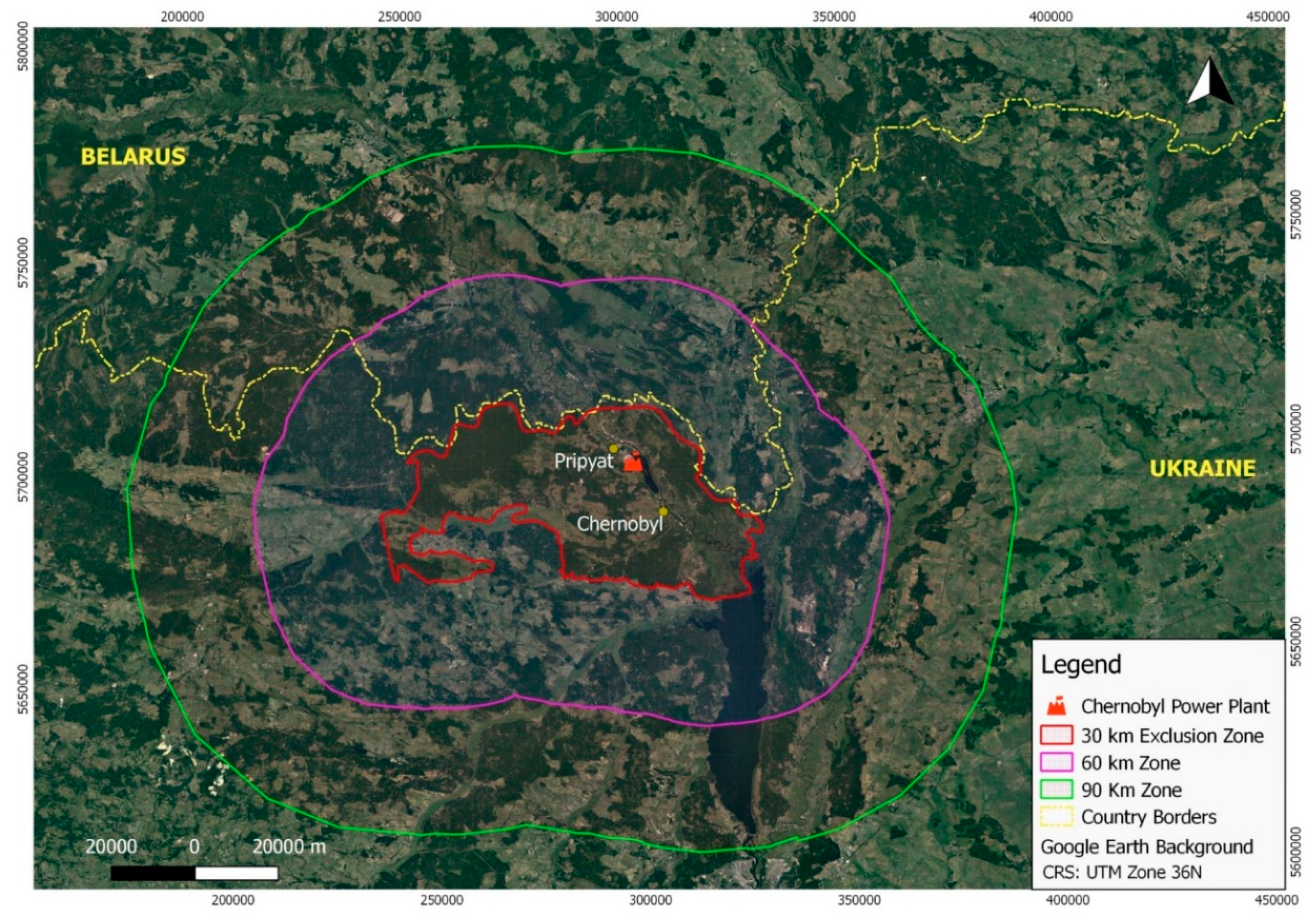
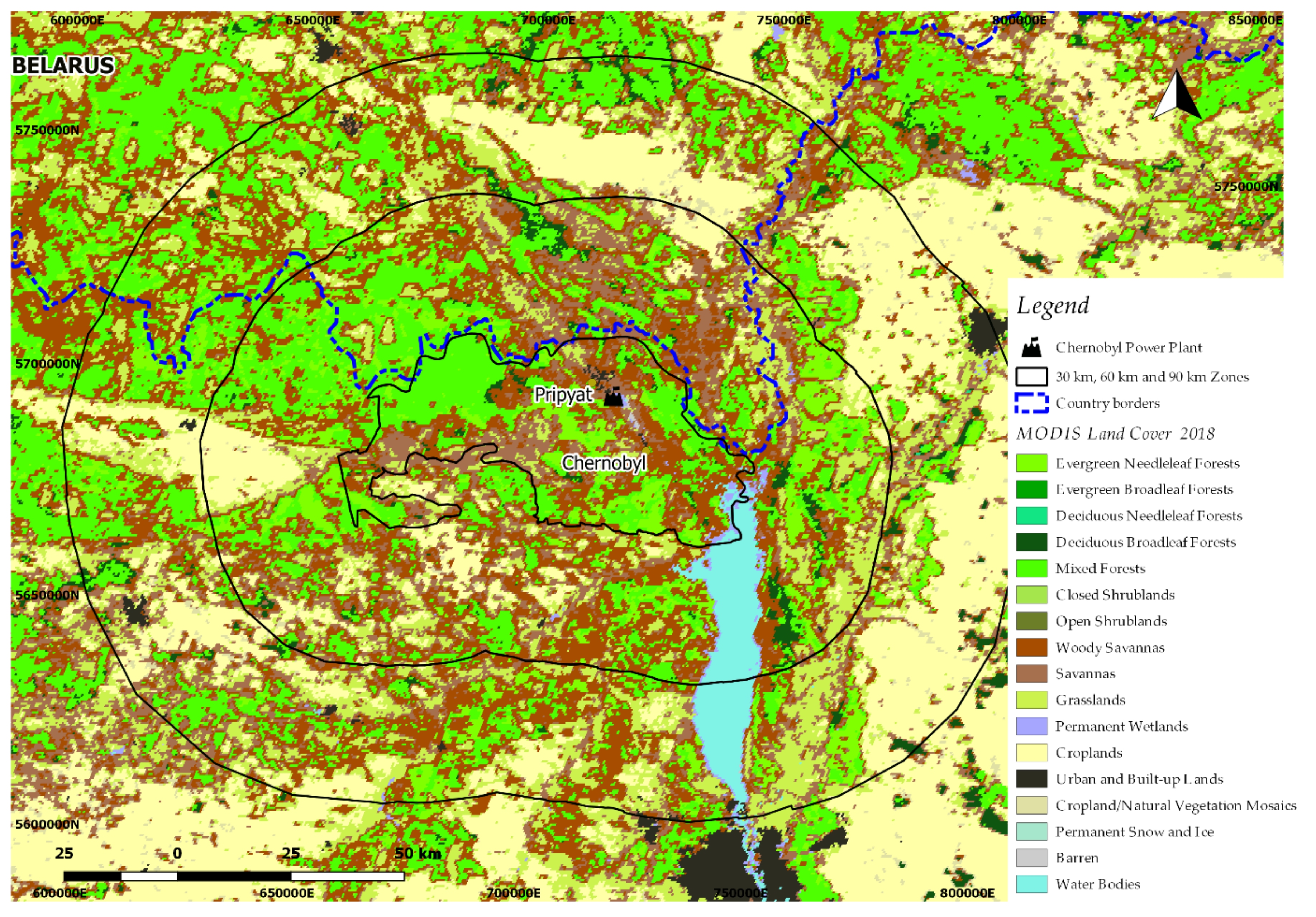

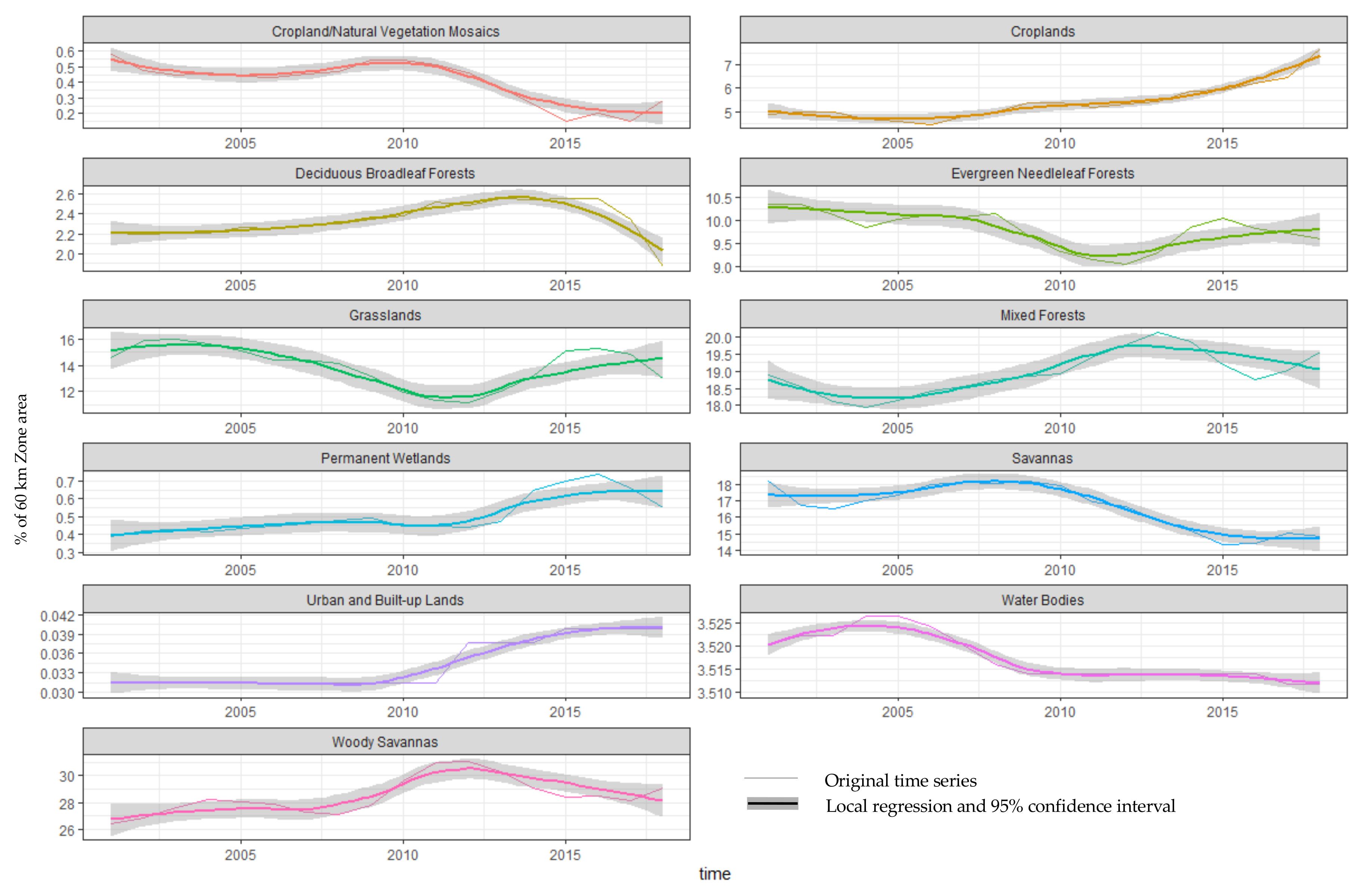
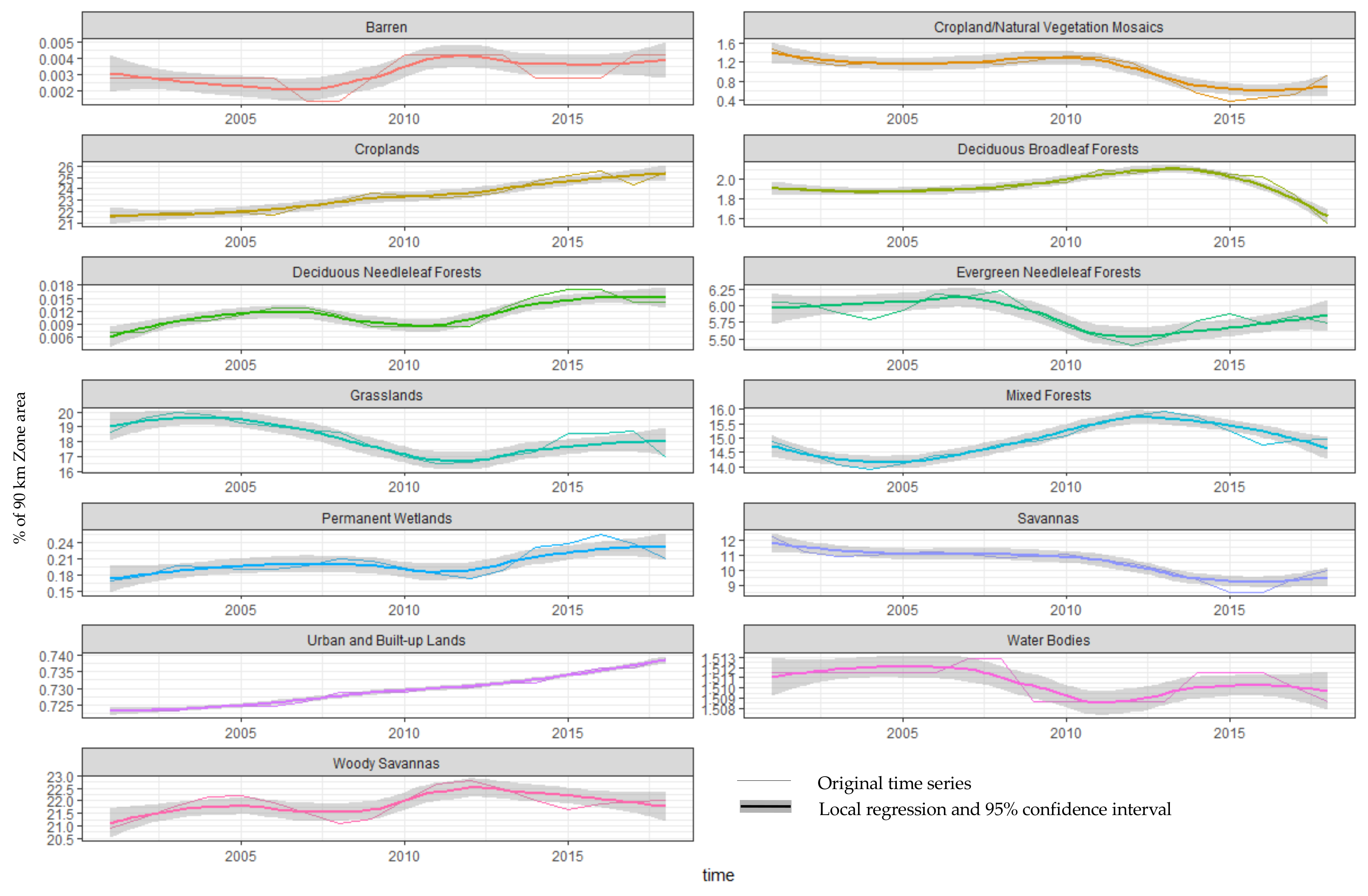
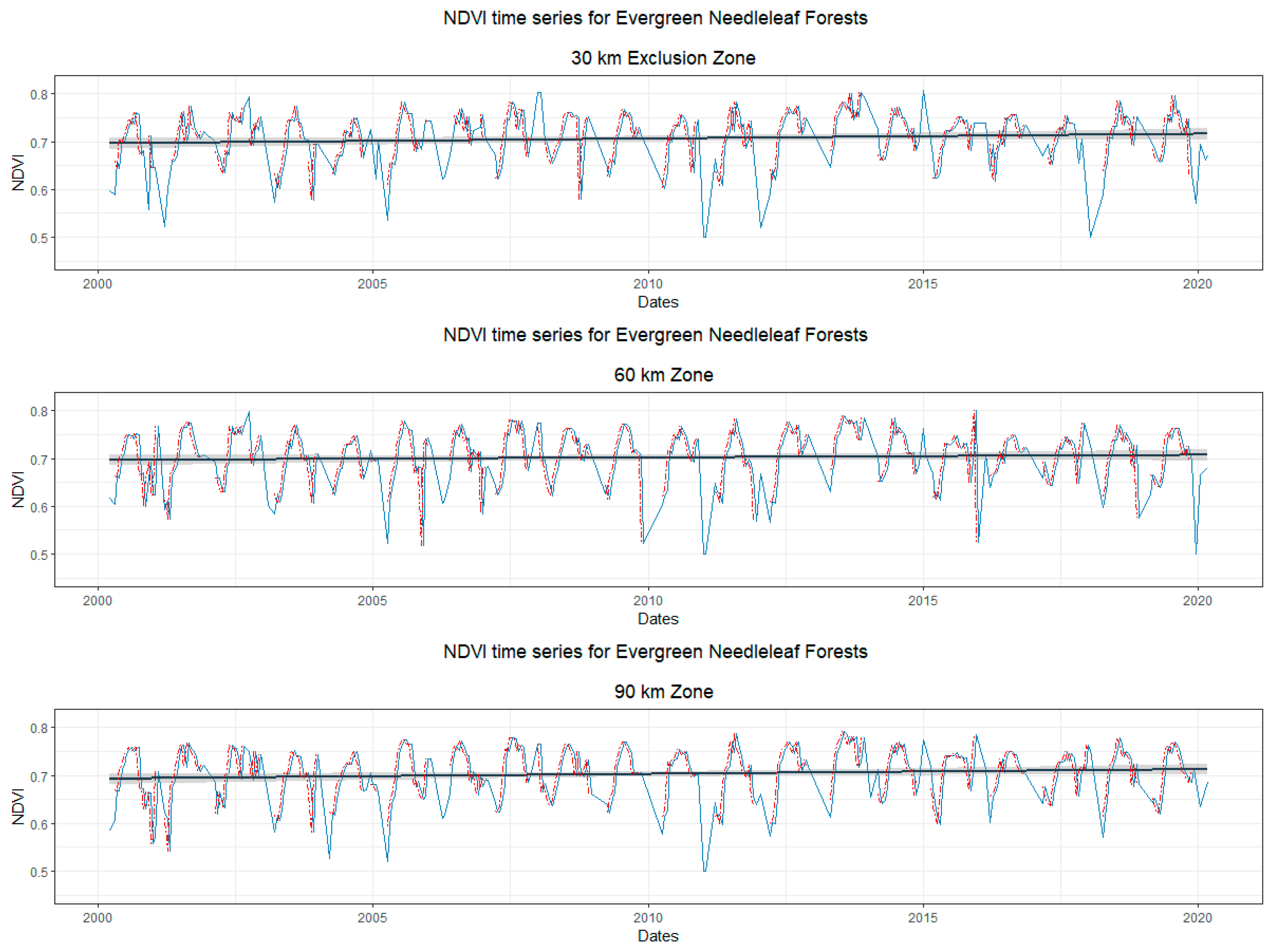
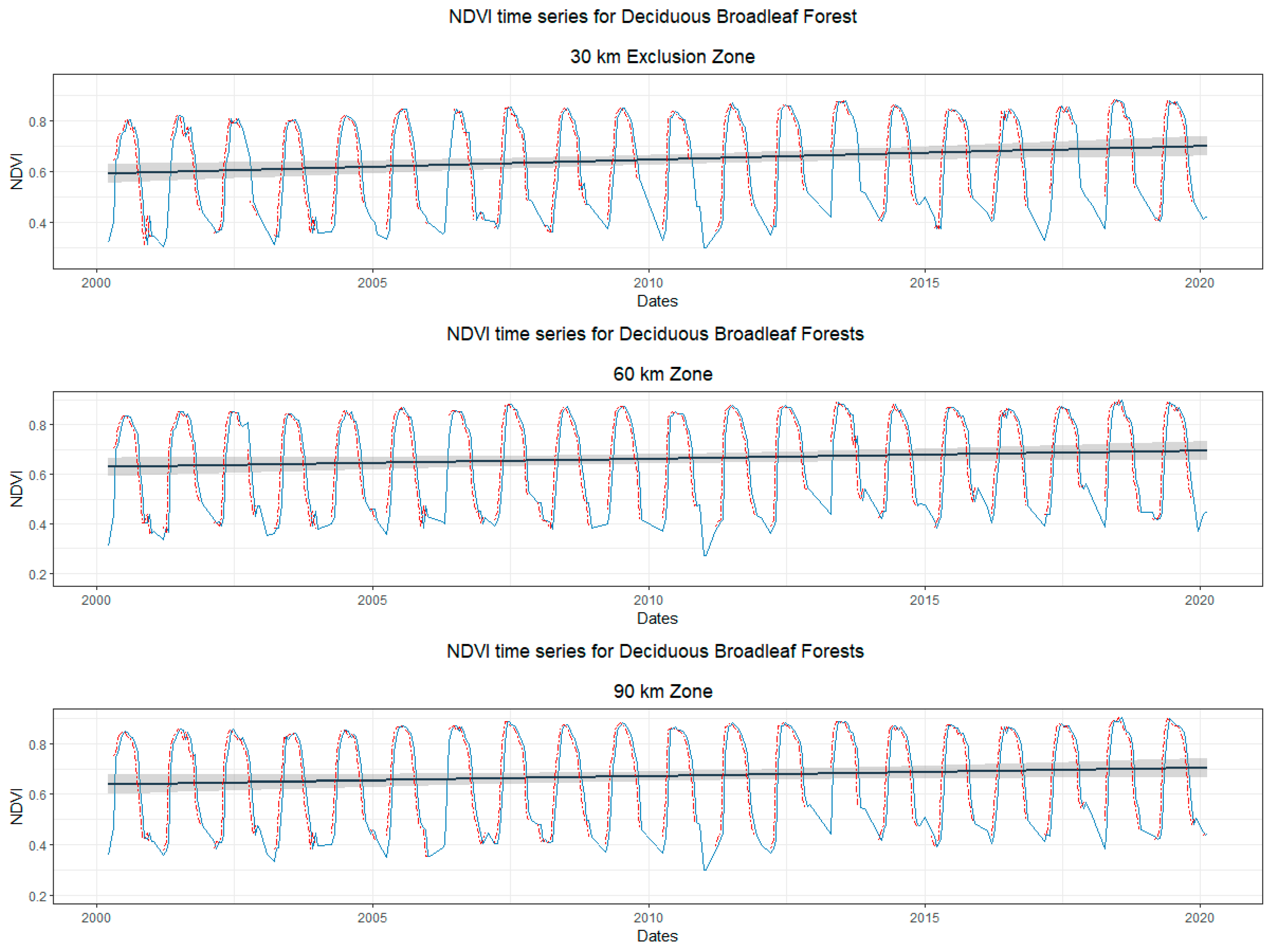

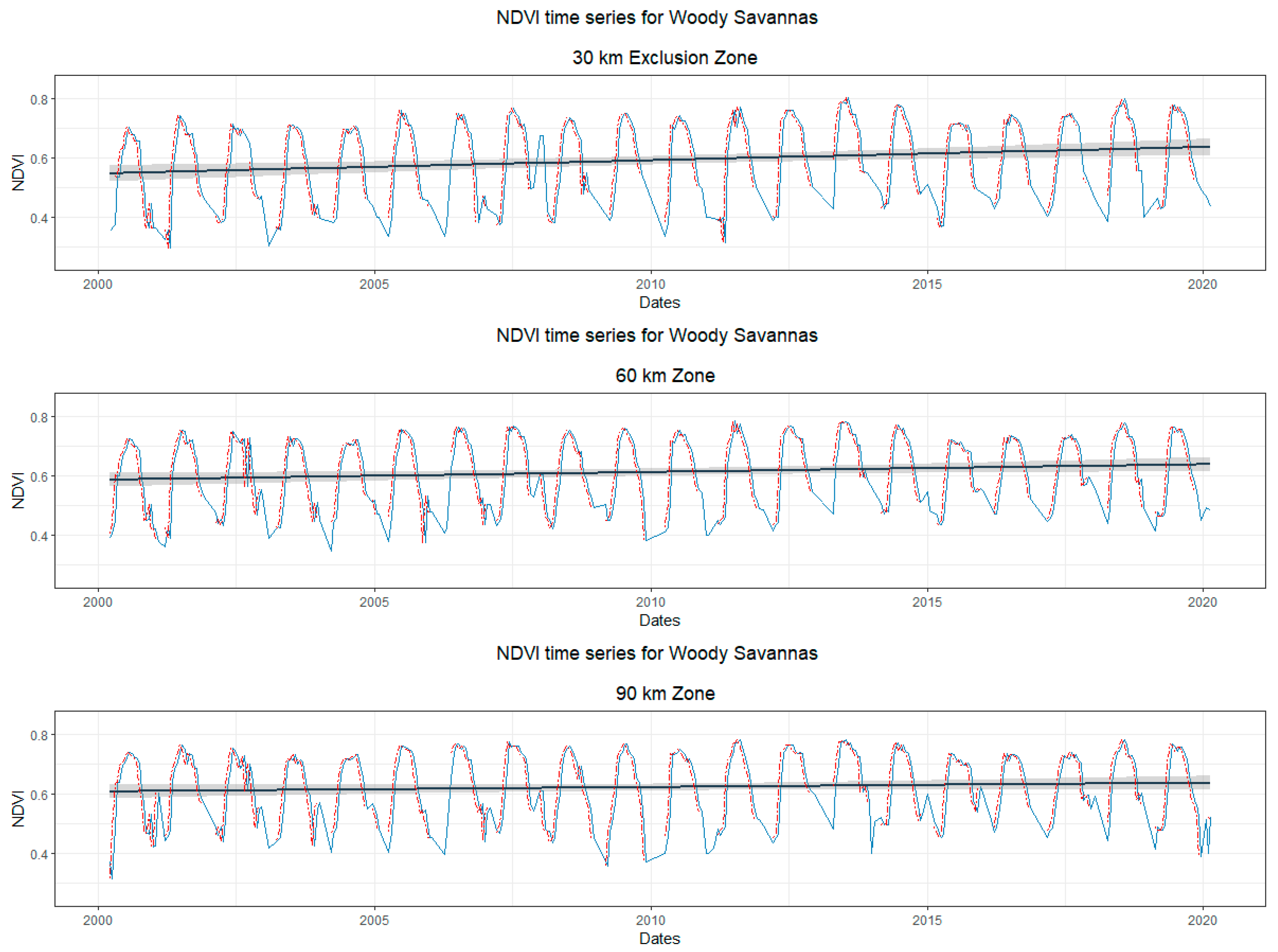

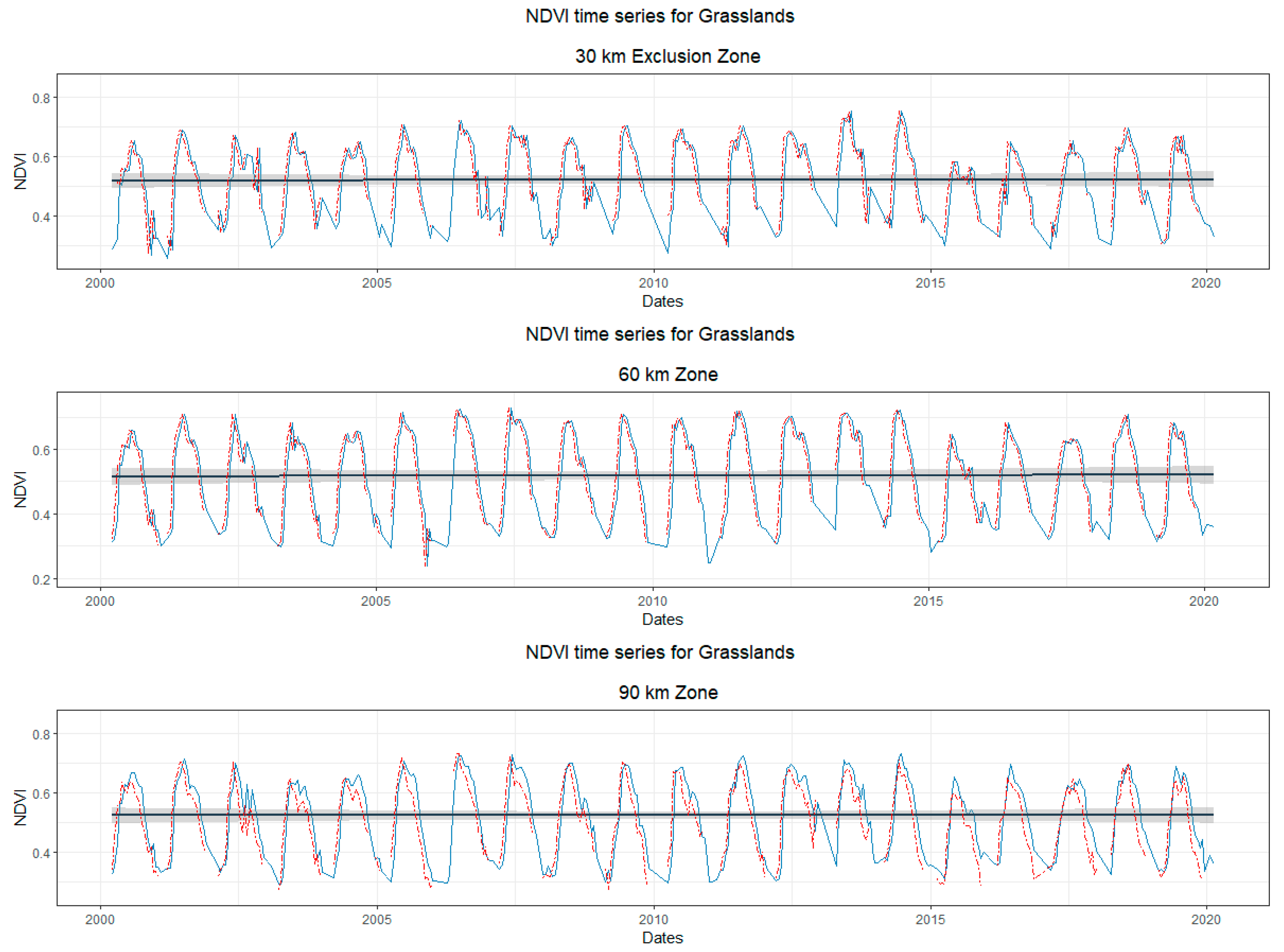
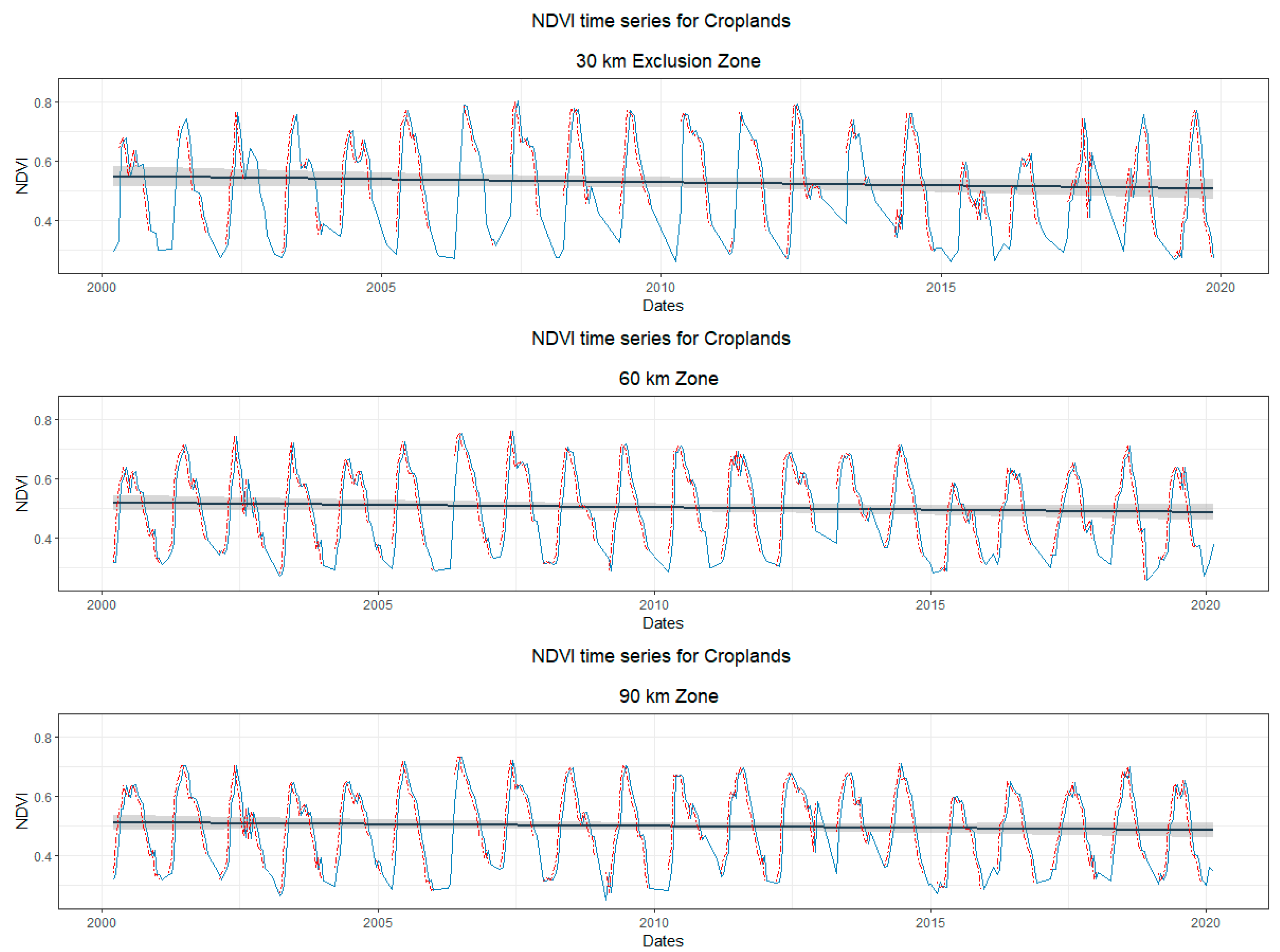

| Land Cover Type | 30 km Exclusion Zone (km2) | 60 km Zone (km2) | 90 km Zone (km2) |
|---|---|---|---|
| Evergreen Needleleaf Forests | 368.8 | 1144.8 | 1014.3 |
| Evergreen Broadleaf Forests | - | - | - |
| Deciduous Needleleaf Forests | - | 0.8 | 2.5 |
| Deciduous Broadleaf Forests | 54.5 | 222.5 | 273.0 |
| Mixed Forests | 836.3 | 2328.8 | 2644.5 |
| Closed Shrublands | - | - | - |
| Open Shrublands | - | - | - |
| Woody Savannas | 900.0 | 3466.0 | 3899.3 |
| Savannas | 475.0 | 1764.5 | 1762.3 |
| Grasslands | 139.3 | 1548.5 | 2995.3 |
| Permanent Wetlands | 29.3 | 65.5 | 37.0 |
| Croplands | 6.3 | 918.5 | 4505.3 |
| Urban and Built-up Lands | 15.5 | 4.8 | 130.8 |
| Cropland/Natural Vegetation Mosaics | - | 34.0 | 166.3 |
| Permanent Snow and Ice | - | - | - |
| Barren | 5.3 | - | 0.8 |
| Water Bodies | 30.8 | 418.5 | 267.0 |
| 30 km Exclusion Zone | 60 km Zone | 90 km Zone | ||||
|---|---|---|---|---|---|---|
| Land Cover Type | Mean NDVI Trend (yr−1) | Area (km2) | Mean NDVI Trend (yr−1) | Area (km2) | Mean NDVI Trend (yr−1) | Area (km2) |
| Evergreen Needleleaf Forests | 1.93 × 10−3 | 177.5 | 1.70 × 10−3 | 242.2 | 3.30 × 10−3 | 44.7 |
| 2.12 × 10−3 | 44.7 | 1.63 × 10−3 | 44.7 | 3.30 × 10−3 | 44.7 | |
| Deciduous Broadleaf Forests | 6.90 × 10−3 | 47.2 | 7.69 × 10−3 | 23.2 | 5.73 × 10−3 | 57.5 |
| 6.93 × 10−3 | 23.2 | 7.69 × 10−3 | 23.2 | 5.66 × 10−3 | 23.2 | |
| Mixed Forests | 5.56 × 10−3 | 231.0 | 5.13 × 10-3 | 529.5 | 5.26 × 10−3 | 196.5 |
| 5.75 × 10−3 | 196.5 | 5.11 × 10−3 | 196.5 | 5.26 × 10−3 | 196.5 | |
| Woody Savannas | 6.85 × 10−3 | 762.5 | 4.63 × 10−3 | 1490.2 | 5.45 × 10−3 | 661.5 |
| 7.01 × 10−3 | 661.5 | 4.21 × 10−3 | 661.5 | 5.45 × 10−3 | 661.5 | |
| Savannas | 5.98 × 10−3 | 24.7 | 3.84 × 10−3 | 498.0 | 4.14 × 10−3 | 293.7 |
| 5.98 × 10−3 | 24.7 | 3.86 × 10−3 | 24.7 | 4.01 × 10−3 | 24.7 | |
| Grasslands | 4.85 × 10−3 | 39.5 | −1.10 × 10−3 | 268.0 | −6.42 × 10−4 | 351.5 |
| 4.85 × 10−3 | 39.5 | −0.85 × 10−3 | 39.5 | −6.11 × 10−4 | 39.5 | |
| Croplands | −5.94 × 10−3 | 3.2 | −5.14 × 10−3 | 228.5 | −3.60 × 10−3 | 385.5 |
| −5.94 × 10−3 | 3.2 | −5.01 × 10−3 | 3.2 | −3.20 × 10−3 | 3.2 | |
| Land Cover Type | Area (km2) | Mean NDVI Trend (yr−1) in 30 km Exclusion Zone | Mean NDVI Trend (yr−1) in 60 km Zone | Mean NDVI Trend (yr−1) in 90 km Zone |
|---|---|---|---|---|
| Evergreen Needleleaf Forests | 295 | 6.67 × 10−4 | 2.99 × 10−4 | 8.52 × 10−4 |
| Deciduous Broadleaf Forests | 48.5 | 4.17 × 10−3 | 2.60 × 10−3 | 2.55 × 10−3 |
| Mixed Forests | 669 | 2.32 × 10−3 | 2.02 × 10−3 | 1.40 × 10−3 |
| Woody Savannas | 720 | 1.29 × 10−2 | 2.01 × 10−3 | 9.30 × 10−4 |
| Savannas | 380 | 2.16 × 10−3 | 1.12 × 10−3 | 8.24 × 10−4 |
| Grasslands | 108.7 | −2.94 × 10−4 | −2.90 × 10−4 | −1.24 × 10−4 |
| Croplands | 5 | −3.31 × 10−3, * | −2.24 × 10−3, * | −1.44 × 10−3 |
| Urban and Built-up Lands | 4 | 5.37 × 10−3, * | 2.18 × 10−3, * | 1.50 × 10−3, * |
Publisher’s Note: MDPI stays neutral with regard to jurisdictional claims in published maps and institutional affiliations. |
© 2020 by the author. Licensee MDPI, Basel, Switzerland. This article is an open access article distributed under the terms and conditions of the Creative Commons Attribution (CC BY) license (http://creativecommons.org/licenses/by/4.0/).
Share and Cite
Gemitzi, A. Are Vegetation Dynamics Impacted from a Nuclear Disaster? The Case of Chernobyl Using Remotely Sensed NDVI and Land Cover Data. Land 2020, 9, 433. https://doi.org/10.3390/land9110433
Gemitzi A. Are Vegetation Dynamics Impacted from a Nuclear Disaster? The Case of Chernobyl Using Remotely Sensed NDVI and Land Cover Data. Land. 2020; 9(11):433. https://doi.org/10.3390/land9110433
Chicago/Turabian StyleGemitzi, Alexandra. 2020. "Are Vegetation Dynamics Impacted from a Nuclear Disaster? The Case of Chernobyl Using Remotely Sensed NDVI and Land Cover Data" Land 9, no. 11: 433. https://doi.org/10.3390/land9110433
APA StyleGemitzi, A. (2020). Are Vegetation Dynamics Impacted from a Nuclear Disaster? The Case of Chernobyl Using Remotely Sensed NDVI and Land Cover Data. Land, 9(11), 433. https://doi.org/10.3390/land9110433






